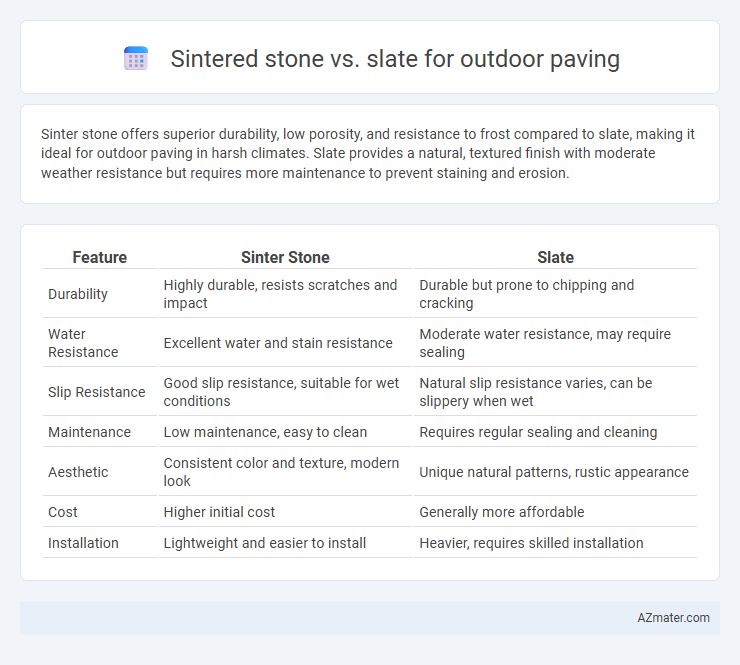Sinter stone offers superior durability, low porosity, and resistance to frost compared to slate, making it ideal for outdoor paving in harsh climates. Slate provides a natural, textured finish with moderate weather resistance but requires more maintenance to prevent staining and erosion.
Table of Comparison
| Feature | Sinter Stone | Slate |
|---|---|---|
| Durability | Highly durable, resists scratches and impact | Durable but prone to chipping and cracking |
| Water Resistance | Excellent water and stain resistance | Moderate water resistance, may require sealing |
| Slip Resistance | Good slip resistance, suitable for wet conditions | Natural slip resistance varies, can be slippery when wet |
| Maintenance | Low maintenance, easy to clean | Requires regular sealing and cleaning |
| Aesthetic | Consistent color and texture, modern look | Unique natural patterns, rustic appearance |
| Cost | Higher initial cost | Generally more affordable |
| Installation | Lightweight and easier to install | Heavier, requires skilled installation |
Introduction to Sinter Stone and Slate
Sinter stone is a dense, engineered material made by sintering natural minerals at high temperatures, offering exceptional durability and resistance to weathering for outdoor paving. Slate, a natural metamorphic rock formed from shale, is renowned for its unique layered texture and excellent slip resistance, making it a popular choice for outdoor applications. Both materials provide distinct aesthetic and functional benefits, with sinter stone excelling in uniformity and low maintenance, while slate offers natural variation and traditional appeal.
Composition and Manufacturing Process
Sinter stone is composed of natural minerals fused through a high-temperature sintering process, resulting in a highly durable and non-porous material ideal for outdoor paving. Slate, a metamorphic rock formed from clay or volcanic ash under low-grade regional metamorphism, is quarried and then split into thin, smooth slabs for paving applications. The manufacturing of sinter stone involves powder compaction and sintering in industrial ovens, enhancing strength and water resistance, while slate requires minimal processing, relying on its natural cleavage for paving suitability.
Aesthetic Differences: Appearance and Texture
Sinter stone offers a sleek, uniform appearance with a smooth texture that enhances modern outdoor paving designs, while slate presents a natural, rustic look characterized by its layered, uneven surface and rich color variations. The fine-grained consistency of sinter stone creates a more polished and contemporary aesthetic, whereas slate's inherent cleft texture and mineral patterns provide a timeless, organic charm. These distinct visual and tactile qualities influence the overall ambiance, with sinter stone favoring minimalistic elegance and slate delivering rugged, classic appeal.
Durability and Weather Resistance
Sinter stone offers superior durability and weather resistance compared to slate, making it an excellent choice for outdoor paving exposed to harsh climates and heavy foot traffic. Engineered through a high-temperature sintering process, sinter stone resists fading, cracking, and erosion caused by UV rays, frost, and moisture far better than natural slate. Slate, while attractive and naturally slip-resistant, is more prone to chipping and weather-related wear, requiring more maintenance to retain its appearance in outdoor environments.
Slip Resistance and Safety Factors
Sinter stone exhibits superior slip resistance compared to slate, making it a safer option for outdoor paving in wet or icy conditions due to its dense, non-porous surface. Slate, while aesthetically appealing, tends to become slippery when wet because of its natural smooth texture and can pose higher safety risks. Choosing sinter stone enhances safety by providing increased traction and durability against environmental wear.
Maintenance and Cleaning Requirements
Sinter stone offers superior resistance to stains and requires minimal maintenance compared to slate, making it ideal for outdoor paving with heavy foot traffic. Slate, while aesthetically appealing, demands regular sealing and specialized cleaning to prevent moisture absorption and surface deterioration. Both materials benefit from routine debris removal, but sinter stone's durability reduces the frequency and intensity of maintenance needed.
Environmental Impact and Sustainability
Sinter stone offers a sustainable outdoor paving option due to its energy-efficient manufacturing process and high durability, which reduces the need for frequent replacement and minimizes environmental waste. Slate, while a natural stone with a lower carbon footprint from quarrying, often requires more intensive maintenance and sealing, potentially increasing its overall ecological impact. Choosing sinter stone supports long-term sustainability through its recyclability and resistance to weathering, making it an eco-friendly alternative to traditional slate paving.
Cost Comparison and Budget Considerations
Sinter stone typically costs more per square foot than slate due to its advanced manufacturing process and enhanced durability, making it a premium choice for outdoor paving. Slate offers a more budget-friendly option with natural variations and moderate maintenance needs, appealing to cost-conscious projects. Evaluating long-term expenses like installation, maintenance, and lifespan is crucial for accurate budget planning when choosing between sinter stone and slate.
Installation Process and Techniques
Sintered stone offers a lightweight and uniform surface, allowing for easier cutting and faster installation with adhesive or mechanical fixing, making it ideal for complex layouts and precise joints in outdoor paving. Slate requires more careful handling due to its natural cleft surface and variable thickness, often necessitating mortar bed installation and professional grading to ensure stability and proper drainage. Both materials benefit from proper substrate preparation, yet sintered stone's consistency reduces the need for extensive leveling compared to slate, streamlining the overall paving process.
Which is Best for Outdoor Paving?
Sinter stone offers superior durability and resistance to weathering, making it ideal for outdoor paving compared to slate, which is softer and more prone to chipping. Its non-porous surface resists stains and requires less maintenance, while slate's natural cleft texture provides a unique aesthetic but demands regular sealing to prevent water damage. For long-lasting, low-maintenance outdoor paving, sinter stone is generally considered the best choice.

Infographic: Sinter stone vs Slate for Outdoor paving
 azmater.com
azmater.com